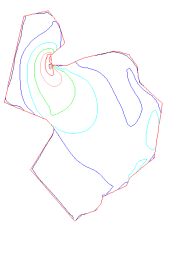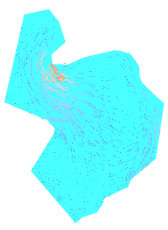Lake Karla
We have studied the three-dimensional numerical simulations in a modeled representation of the reconstituted lake Karla, located at Thessaly, Central Greece, in order to discuss the dominant water flow current patterns. In the present model simulation, the flow is generated mainly by the wind shear stress, as modified also by water inflow in three existing channels placed in specific locations of the lake and an outlet. The effect of wind blow speed magnitude together with its blowing direction, found to be the dominant reasons of the water recirculation currents, are discussed based on meteorological data from local weather stations. The present results show that the contour of the lake boundary has a significant influence on the water velocity. As a result of the lake’s contour, the water is found to be in highly motion for N-NW wind directions and to be slower for SW and NE wind directions. Although simulations were performed for all possible wind blow directions, only two dominant patterns in the lake are found to be formed due to different wind blow directions. The existence of surface water recirculations is found to be dependent only by the wind speed, however, possible horizontal water recirculations maybe submerged beneath the surface. The presented hydrodynamic model constitutes the basis for the development of models for heat and mass transport in the Karla reservoir. Results of the spatio-temporal distribution of a passive scalar in the lake are finally presented for an idealized mass transfer problem. Slow contamination zone formation and advection from the inflows to the outlet is found due to the weak water currents.

